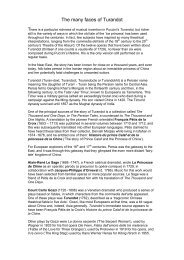NEF-Southampton-Positive-Money-ICB-Submission
NEF-Southampton-Positive-Money-ICB-Submission
NEF-Southampton-Positive-Money-ICB-Submission
Create successful ePaper yourself
Turn your PDF publications into a flip-book with our unique Google optimized e-Paper software.
APPENDIX 1: How We Got Here – The 1844 Bank Charter Act<br />
Prior to 1844, commercial banks were allowed to print their own pound sterling bank notes, while coins could<br />
only be created by the state. Over Gme, banks started to issue (print) and lend out so many bank notes that<br />
they caused significant inflaGon and destabilised the enGre economy.<br />
In response, the government of Robert Peel passed the 1844 Bank Charter Act, which made it illegal for<br />
anyone other than the Bank of England to print pound sterling bank notes. In theory, this should have<br />
returned control over the money supply of the naGon back to the state.<br />
Number <strong>Money</strong> (Bank Deposits)<br />
However, the 1844 Bank Charter Act did not make it illegal for banks to create ‘bank deposits’ -‐ the numbers<br />
in your bank account, and in the bank accounts of any ciGzen or company in the country. With the rise of the<br />
digital age, these bank deposits are now the primary means of payment, used in 99.91% of transacGons. 20<br />
The banks are able to create bank deposits through the accounGng process that they use to make loans.<br />
Rather than taking money from a saver and lending it to a borrower (as per the common understanding of<br />
banking), they simply write new numbers into the bank account of a borrower -‐ effecGvely creaGng new<br />
money. Their only constraint in this process is the need to have a small pool of central bank money at the<br />
Bank of England, but as more in-‐depth briefings can explain, in pracGce this does not act as a constraint upon<br />
the lending of banks.<br />
Without seeing the process in acGon, it can be a liOle hard to believe. A comprehensive and fully referenced<br />
explanaGon of this money creaGon process is available from PosiGve <strong>Money</strong> but below are a few quotes<br />
‘straight from the horse’s mouth’ which confirm this amazing fact:<br />
“...by far the largest role in creaGng broad money is played by the banking sector... when banks make<br />
loans they create addiGonal deposits for those that have borrowed the money.”<br />
-‐ Bank of England Quarterly BulleGn, 2007 Q3<br />
“Subject only but crucially to confidence in their soundness, banks extend credit by simply increasing<br />
the borrowing customer’s current account, which can be paid away to wherever the borrower wants by<br />
the bank ‘wriGng a cheque on itself’. That is, banks extend credit by creaGng money.”<br />
-‐ Paul Tucker, Deputy Governor of the Bank of England and member of the Monetary Policy CommiOee<br />
"... changes in the money stock primarily reflect developments in bank lending as new deposits are<br />
created."<br />
-‐ Bank of England Quarterly BulleGn 2007 Q3, p378<br />
"...the banking sector plays such an important role in the creaGon of money. Changes in the terms for<br />
deposits will affect the demand for money, while changes in the terms for loans will affect the amount<br />
20 Bank of England Payment Systems Oversight Report: h:p://www.bankofengland.co.uk/publicaAons/psor/<br />
31



